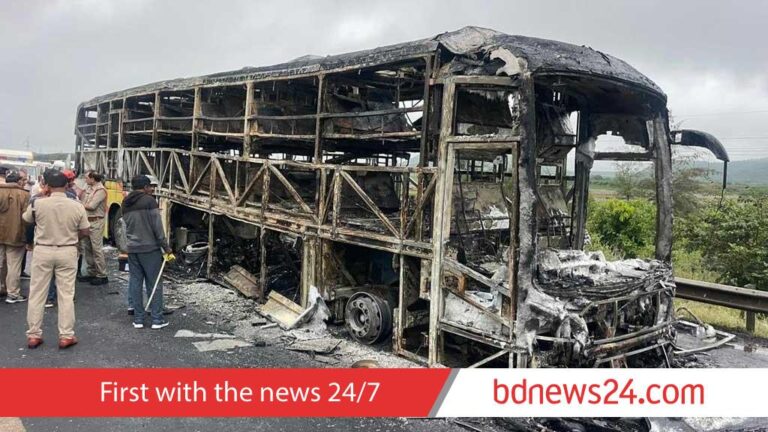A devastating fire engulfed a passenger bus in India, with reports indicating that hundreds of smartphones on board intensified the blaze. The incident, which occurred during a routine journey, has raised concerns over the safety risks posed by electronic devices in enclosed spaces. Authorities are investigating the cause of the fire and assessing the extent of injuries and damages as details continue to emerge.
India Bus Fire Investigation Reveals Role of Smartphones in Accelerating Blaze
Investigators examining the tragic bus fire in India have uncovered a surprising factor that worsened the disaster: the presence of hundreds of smartphones on board. Preliminary analysis indicates that the lithium-ion batteries in these devices significantly accelerated the intensity and spread of the flames. Experts believe that when exposed to extreme heat, these batteries can undergo thermal runaway – a rapid, uncontrollable chemical reaction – releasing flammable gases and increasing the overall fire hazard inside confined spaces like vehicles.
The fire department’s report highlights several key findings regarding the role of smartphones during the incident:
- Thermal Runaway Effect: Multiple smartphones overheating simultaneously served as a catalyst for the fire’s rapid expansion.
- Ignition Sources: Charging devices or damaged batteries are likely ignition points that sparked the blaze.
- Fire Containment Challenges: The combination of a closed bus environment and battery combustion compounds hindered firefighting efforts.
| Factor | Impact on Fire |
|---|---|
| Number of Smartphones | Estimated 300+ |
| Battery Incidents | Approx. 15 thermal failures |
| Fire Spread Time | Under 10 minutes |
| Firefighting Difficulty | Significantly increased |
Safety Concerns Raised Over Lithium-Ion Batteries in Public Transportation
The recent bus fire tragedy in India, exacerbated by the presence of numerous lithium-ion smartphone batteries, has reignited serious debates over the safety protocols surrounding the use of such batteries in public transportation. Experts point out that while lithium-ion batteries are ubiquitous due to their efficiency and lightweight properties, their highly flammable electrolyte and potential for thermal runaway pose significant risks when involved in fires. The sheer volume of smartphones onboard the bus contributed to the rapid spread and intensity of the blaze, complicating rescue efforts and increasing casualties.
Authorities and safety analysts are now calling for stringent regulations, including:
- Mandatory use of fire-retardant materials in vehicle construction.
- Strict guidelines for safe battery storage during transit.
- Emergency response training tailored for lithium-ion fire scenarios.
- Regular safety audits focusing on electronic device carriage.
Below is a comparison of fire risks associated with different types of batteries commonly found in public transport settings:
| Battery Type | Flammability Risk | Typical Use |
|---|---|---|
| Lithium-Ion | High | Smartphones, Laptops |
| Nickel-Metal Hydride | Moderate | Hybrid Cars, Power Tools |
| Lead-Acid | Low | Heavy Vehicles, Backup Power |
Experts Urge Strict Regulations and Emergency Protocols to Prevent Similar Tragedies
In the wake of the devastating bus fire, safety experts have strongly advocated for the implementation of stringent regulations aimed at curbing the risk of similar disasters. Central to their recommendations is the mandatory restriction on carrying large quantities of electronic devices with lithium-ion batteries in public transport vehicles. These devices, when damaged or overheated, pose a heightened fire hazard, a risk underscored by the recent tragedy where hundreds of smartphones reportedly fueled the blaze.
Emergency response protocols are also under the spotlight, with calls for comprehensive training of bus staff and clear evacuation procedures. Experts emphasize the need for:
- Regular fire safety drills tailored to public transport settings
- Equipping buses with fire extinguishers and smoke detectors
- Strict inspection routines to ensure electronic device safety compliance
- Improved communication systems for rapid emergency alerts
| Recommended Safety Measure | Expected Impact |
|---|---|
| Device Carrying Limits | Reduced fire risk onboard |
| Safety Equipment Installation | Faster fire containment |
| Staff Fire Safety Training | Quicker, coordinated evacuations |
| Emergency Communication Upgrades | Timely alerts for passengers and responders |
To Wrap It Up
The tragic incident of the bus fire in India highlights the unforeseen dangers posed by the widespread use of smartphones and other electronic devices. As investigators continue to examine the exact cause and contributing factors, authorities are urged to reassess safety protocols for the transport of electronic goods. This devastating event serves as a stark reminder of the importance of stringent regulations and heightened awareness to prevent such occurrences in the future.




